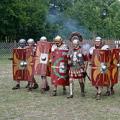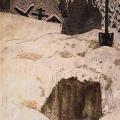Empirical formulas for calculating the areas of simple figures. How to find the area of geometric shapes
All formulas for the area of plane figures
Area of an isosceles trapezoid
1. Formula for the area of an isosceles trapezoid using sides and angles
a - lower base
b - upper base
c - equal sides
α - angle at the lower base
Formula for the area of an isosceles trapezoid through the sides, (S):

Formula for the area of an isosceles trapezoid using sides and angles, (S):



2. Formula for the area of an isosceles trapezoid in terms of the radius of the inscribed circle
R - radius of the inscribed circle
D - diameter of the inscribed circle
O - center of the inscribed circle
α, β - trapezoid angles
Formula for the area of an isosceles trapezoid in terms of the radius of the inscribed circle, (S):

FAIR, for an inscribed circle in an isosceles trapezoid:

3. Formula for the area of an isosceles trapezoid through the diagonals and the angle between them
d- diagonal of trapezoid
α,β- angles between diagonals
Formula for the area of an isosceles trapezoid through the diagonals and the angle between them, (S):

4. Formula for the area of an isosceles trapezoid through midline, side and corner at the base
c- side
m - midline of trapezoid
α, β - angles at the base
Formula for the area of an isosceles trapezoid using the midline, lateral side and base angle,
(S): 
5. Formula for the area of an isosceles trapezoid using bases and height
a - lower base
b - upper base
h - height of the trapezoid

Formula for the area of an isosceles trapezoid using bases and height, (S):
Area of a triangle based on a side and two angles, formula.
a, b, c - sides of the triangle
α, β, γ - opposite angles
Area of a triangle through a side and two angles (S):



Formula for the area of a regular polygon
a - side of the polygon
n - number of sides
Area of a regular polygon, (S):

Formula (Heron) for the area of a triangle through the semiperimeter (S):
The area of an equilateral triangle is:
Formulas for calculating the area of an equilateral triangle.
a - side of the triangle
h – height


How to calculate the area of an isosceles triangle?
b - base of the triangle
a - equal sides
h – height

3. Formula for the area of a trapezoid using four sides
a - lower base
b - upper base
c, d - sides

Radius of the circumscribed circle of a trapezoid along the sides and diagonals
a - lateral sides of the trapezoid
c - lower base
b - upper base
d - diagonal
h - height
Trapezoid circumradius formula, (R)

find the circumradius of an isosceles triangle using the sides
Knowing the sides of an isosceles triangle, you can use the formula to find the radius of the circumscribed circle around this triangle.
a, b - sides of the triangle
Circumradius of an isosceles triangle (R):

Radius of the inscribed circle in a hexagon
a - side of the hexagon
Radius of the inscribed circle in a hexagon, (r):


Radius of the inscribed circle in a rhombus
r - radius of the inscribed circle
a - side of the rhombus
D, d - diagonals
h - height of the rhombus

Radius of the inscribed circle in an equilateral trapezoid
c - lower base
b - upper base
a - sides
h - height

Radius of the inscribed circle in a right triangle
a, b - legs of the triangle
c - hypotenuse

Radius of the inscribed circle in an isosceles triangle
a, b - sides of the triangle


Prove that the area of an inscribed quadrilateral is
\/(р - а)(р - b) (р - с) (р - d),
where p is the semi-perimeter and a, b, c and d are the sides of the quadrilateral.
Prove that the area of a quadrilateral inscribed in a circle is equal to
1/2 (ab + cb) · sin α, where a, b, c and d are the sides of the quadrilateral and α is the angle between sides a and b.
S = √[ a ƀ c d] sin ½ (α + β). - Read more on FB.ru:
The area of an arbitrary quadrilateral (Fig. 1.13) can be expressed through its sides a, b, c and the sum of a pair of opposite angles:
where p is the semi-perimeter of the quadrilateral.
The area of a quadrilateral inscribed in a circle () (Fig. 1.14, a) is calculated using Brahmagupta’s formula
and described (Fig. 1.14, b) () - according to the formula
If the quadrilateral is inscribed and described at the same time (Fig. 1.14, c), then the formula becomes very simple:
Pick's formula
To estimate the area of a polygon on checkered paper, it is enough to count how many cells this polygon covers (we take the area of a cell as one). More precisely, if S is the area of the polygon, is the number of cells that lie entirely inside the polygon, and is the number of cells that have at least one common point with the interior of the polygon.
Below we will consider only those polygons all of whose vertices lie in the nodes of the checkered paper - those where the grid lines intersect. It turns out that for such polygons one can specify the following formula:
where is the area, r is the number of nodes that lie strictly inside the polygon.
This formula is called the “Pick formula” - after the mathematician who discovered it in 1899.
To solve geometry problems, you need to know formulas - such as the area of a triangle or the area of a parallelogram - as well as simple techniques, which we will talk about.
First, let's learn the formulas for the areas of figures. We have specially collected them in a convenient table. Print, learn and apply!
Of course, not all geometry formulas are in our table. For example, to solve problems in geometry and stereometry in the second part profile Unified State Examination In mathematics, other formulas for the area of a triangle are also used. We will definitely tell you about them.
What to do if you need to find not the area of a trapezoid or triangle, but the area of some complex figure? Eat universal methods! We will show them using examples from the FIPI task bank.
1. How to find the area of a non-standard figure? For example, an arbitrary quadrilateral? A simple technique - let's divide this figure into those that we know everything about, and find its area - as the sum of the areas of these figures.

Divide this quadrilateral with a horizontal line into two triangles with common ground, equal to . The heights of these triangles are equal to and . Then the area of the quadrilateral is equal to the sum of the areas of the two triangles: .
Answer: .
2. In some cases, the area of a figure can be represented as the difference of some areas.

It is not so easy to calculate what the base and height of this triangle are equal to! But we can say that its area is equal to the difference between the areas of a square with a side and three right triangles. Do you see them in the picture? We get: .
Answer: .
3. Sometimes in a task you need to find the area of not the entire figure, but part of it. Usually we are talking about the area of a sector - part of a circle. Find the area of a sector of a circle of radius whose arc length is equal to .

In this picture we see part of a circle. The area of the entire circle is equal to . It remains to find out which part of the circle is depicted. Since the length of the entire circle is equal (since), and the length of the arc of a given sector is equal, therefore, the length of the arc is a factor of less than the length of the entire circle. The angle at which this arc rests is also a factor of less than a full circle (that is, degrees). This means that the area of the sector will be several times smaller than the area of the entire circle.
What is area?
Area is a characteristic of a closed geometric figure (circle, square, triangle, etc.), which shows its size. Area is measured in square centimeters, meters, etc. Denoted by the letter S(square).
How to find the area of a triangle?
S= a h
Where a– base length, h– the height of the triangle drawn to the base.

Moreover, the base does not have to be at the bottom. That will do too.

If a triangle obtuse, then the height is lowered to the continuation of the base:

If a triangle rectangular, then the base and height are its legs:

2. Another formula, which is no less useful, but which for some reason is always forgotten:
S= a b sinα
Where a And b- two sides of the triangle, sinα is the sine of the angle between these sides.


The main condition is that the angle is taken between two known sides.
3. Formula for area on three sides (Heron’s formula):
S=
Where a, b And With are the sides of the triangle, and R - semi-perimeter p = (a+b+c)/2.

4. Formula for the area of a triangle in terms of the radius of the circumcircle:
S=
Where a, b And With are the sides of the triangle, and R – radius of the circumscribed circle.

5. Formula for the area of a triangle in terms of the radius of the inscribed circle:
S= p · r
Where R - semiperimeter of a triangle, and r – radius of the inscribed circle.

How to find the area of a rectangle?
1. The area of a rectangle is found quite simply:
S=a b
No tricks.
How to find the area of a square?
1. Since a square is a rectangle with all sides equal, the same formula applies to it:
S=a · a = a 2
2. Also, the area of a square can be found through its diagonal:
S= d 2
How to find the area of a parallelogram?
1. The area of a parallelogram is found by the formula:
S=a h
This is due to the fact that if you cut it off right triangle on the right and place it on the left, you get a rectangle:

2. Also, the area of a parallelogram can be found through the angle between two sides:
S=a · b · sinα

How to find the area of a rhombus?
A rhombus is essentially a parallelogram with all sides equal. Therefore, the same area formulas apply to it.
1. Area of a rhombus through height:
S=a h




 See what “Legion (number)” is in other dictionaries
See what “Legion (number)” is in other dictionaries Examples of solving problems on the topic “Random variables”
Examples of solving problems on the topic “Random variables” I’m reading the poem “Frost, Red Nose” by Nekrasov
I’m reading the poem “Frost, Red Nose” by Nekrasov